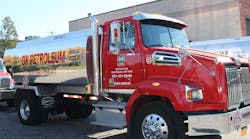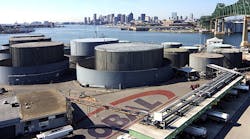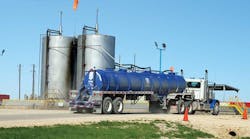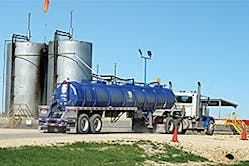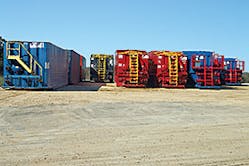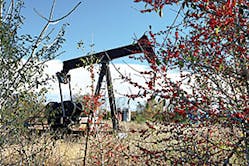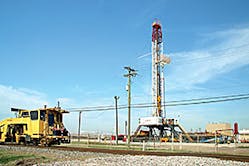“LORD, let there be one more oil boom.”
That bumper sticker dating back to the oil bust of 1986 pretty well sums up the mood in the oilfield service sector today. The industry is still reeling from the international collapse of crude oil prices—and the resulting plummet in US drilling—over the past year.
As of the first week of January 2016, West Texas Intermediate (WTI) crude oil was priced at $33.02 per barrel. The Baker Hughes US rig count at the end of December 2015 stood at 698, down from 1,115 at the end of December 2014. Clearly, the crude oil downturn continues.
It is estimated that the oilfield lost more than 300,000 workers in the current downturn, and the furloughs continue. Oilfield service companies—including crude oil haulers, water transporters, and frac sand and cement haulers—were especially hard hit.
“We’re still seeing major cutbacks in personnel in the service sector, which has accounted for roughly 40% of the job losses,” says Kenny Jordan, executive director of the Association of Energy Service Companies (AESC). “US producers currently have one million to two million barrels per day excess capacity.
“With crude currently at a 14-year low, this year could be even worse for the service sector. We don’t know where the price will bottom out. We expect little or no improvement in the rig count. In fact, the rig count could drop by as much as a hundred over the course of this year.”
Despite the bad news, the sense of optimism in the oilfield community never completely goes away. Oilfield veterans realize that a market turnaround will occur. The big questions are: How much and how soon?
A fresh shot of optimism came with success of the Republican majority in the US House of Representatives and Senate leading the way on repealing the 40-year ban on US crude oil exports. Legislation repealing the export ban was signed into law in mid December 2015, and the first two shipments to Europe were loaded at Texas ports in early January.
“The repeal of the crude oil export ban was good on emotional and economic levels,” Jordan says. “Both of these shipments are headed for Europe and probably were a test to see if there would be any export roadblocks and to see if European refineries can handle our lighter crude.
“We see a lot of positives in this. Hopefully, crude exports will help keep people employed and may even create a few new jobs. Exports will give US producers and marketers more options for the sale of their products. We expect many marketers to ramp up export activity in the coming months.
“More liquefied natural gas (LNG) facilities also are coming online. Many of them were designed and built for the LNG export market.”
Lengthy effort
Jordan adds that although he was thrilled by the successful elimination of the crude oil export ban, he realized the outcome was not a certainty when Congress launched the effort in 2015. Repeal of the crude oil export ban had been discussed for years without any action being taken.
“That didn’t stop us making elimination of the crude oil export ban one of our key talking points during AESC’s Washington DC Fly-in in early 2015,” he says. “We knew there was a lot of skepticism over rolling back the export ban. Even some of our Congressional delegation in Houston (Texas) was against the idea, and they ultimately voted against the legislation.”
A fact sheet handed out during the trip to Washington clearly stated AESC’s position on the oil export issue. The opening statement said: “The United States is quickly becoming the world’s largest producer of oil yet we are constrained by an antiquated oil export ban. The AESC calls for Congress to pass legislation repealing the export ban to all American producers to compete globally.”
The position paper went on to state: “For decades, the United States was confronted with the problem of declining oil production and increasing dependence on imported oil. In the 1970s, OPEC (the Organization of Petroleum Exporting Countries) used its leverage to restrict production and brought severe fuel shortages to Americans. In 1975, the United States responded to these oil shortages by passing the Energy Policy and Conservation Act, which banned most US oil exports.
“America’s fortunes have changed, however. The United States is in the midst of an energy boom. Innovative techniques involving the use of horizontal drilling and hydraulic fracturing have triggered unprecedented increases in production of crude oil, natural gas, and natural gas liquids from shale.
“The US Energy Information Administration (EIA) reported recently that the United States increased oil production by 1.2 million barrels per day during 2014—the largest production increase since the agency began recordkeeping in 1900.
“A vast majority of this new production is from tight oil formations that are yielding light sweet crude. American refineries are generally configured to handle heavier oils, and this reduces the domestic market for these lighter unconventional crudes. These refineries cannot quickly reconfigure to take this lighter crude, which leads to depressed pricing for high-quality oil. A recent study from Rice University found that this unconventional crude would fetch higher prices than crude benchmarks (West Texas Intermediate or Brent) if access to world markets were permitted.”
Broad benefits
At least seven other recent studies also found broad economic benefits in US resumption of crude oil exports. One study estimated 300,000 jobs would be added because of exports, and another concluded that the US economy would add a million jobs as a result of removing export restrictions.
The AESC position paper stated that it is important to note that jobs created in the oilfield have positive impacts on the overall US economy. The World Economic Forum reports that for every one job directly created by the oil and gas sector, three jobs are created in other sectors because of the vast supply chain required for natural resource development.
In its conclusion, the position paper stated: “In addition to job creation, American domestic (oil) production can increase global energy security. In times past, political instability in other regions caused global oil prices to spike and squeeze consumers. Additional production has smoothed oil markets. (US) oil exports would further strengthen the global economy through a more predictable supply of a critical commodity.”
Oilfield report page 2...
Current events appear to be lending credence to the points made in the AESC position paper. Lifting of the export ban seems to have helped moderate the pricing differential between WTI and Brent crude. Americans are benefitting from some of the lowest gasoline prices in decades despite the growing turmoil in the Middle East.
Service sector
It is the oilfield service sector that keeps that US crude oil flowing to US refineries and the export markets. Many of the service companies that are so critical to the US oil industry are making significant adjustments to respond to the market downturn, according to Joyce Ryel, AESC president and a senior executive at Superior Energy, one of the many oilfield service companies.
“These companies have seen downturns before, and they are digging in for the longhaul,” she says. “Most of the companies that haul things like crude oil, water, and frac sand are holding onto their fleet equipment. Some are parking their oldest trucks. Many are cutting back to a single shift and reducing worker hours.
“They are all waiting for things to turn around for the better. They all want to be in a good position to respond when the market recovers. Predicting when that recovery will take place is a more difficult question.”
While drilling activity has plunged, oil wells are still being drilled. In addition, existing wells across the United States continue to produce crude oil, natural gas, and condensate. The energy products must be handled and the infrastructure must be maintained.
The oilfield service sector handles virtually everything that happens after a well is drilled. That includes the fracing process, as well as well rework, water and crude hauling, process and flow-back water disposal, pump changeouts, and everything else that goes into the process of producing oil and gas.
Long life
Many wells remain productive for decades. Those wells will produce many thousands of barrels of oil and water during their useful lives. The amount of water coming out of the wells sometimes exceeds by a substantial margin the quantity of oil produced.
“Stripper wells are a good example,” Jordan says. “They don’t generate a lot of oil, but they produce a lot of water that must be collected regularly for disposal. To maintain oil production, service companies can stimulate the will with acid or re-frac various zones in a horizontally drilled well. Shutting down a well that is no longer cost-justified is a very labor-intensive process that is also handled by oilfield service companies.”
These service providers face intense challenges today. On the economic side, oilfield service companies are under continued pressure from their customers to cut prices. Many oil and gas producers are demanding steep discounts in the 40% to 60% range.
With layoffs continuing, the service sector is losing many of its most promising workers. “The first cutbacks targeted younger workers, and now we are seeing layoffs of very experienced workers,” Jordan says. “If the oilfield ramps up quickly, I don’t believe we will have enough trained workers on hand. That is a serious concern for the future.”
Regulatory impact
On the regulatory side, new Occupational Safety and Health Administration (OSHA) rules focus on exposure to silica dust during frac sand handling. “We’re going to see more OSHA enforcement and higher penalties,” Jordan says.
He adds that oilfield safety is a serious concern for AESC. “It is critical for the companies in this industry to build strong safety cultures and safety programs,” he says. “We still have too many oilfield fatalities. Transportation accounts for 40% of fatal oilfield worker accidents, many of which occur in light-duty vehicles.”
Bad roads have been a contributing factor in some of the fatal accidents, and states are taking different approaches to deal with road damage in areas with heavy oilfield traffic. For instance, the Texas state legislature appropriated significantly more money during the last session to cover road and highway construction and maintenance in the oil and gas fields across the state.
“With the oil industry downturn, we’re also seeing a drop in traffic, especially drilling rig moves, which were the heaviest loads,” Jordan says.
Thirty-minute rest breaks mandated under the federal driver hours-of-service rules are getting more attention from trucking operations in the oilfield. Ryel says the requirement does not seem to be a natural fit for oilfield service operations, which are mostly local intrastate hauls.
“This rule was intended for interstate over-the-road trucking operations,” she says. “Texas doesn’t require it for intrastate operations, and Oklahoma legislation suggests a similar approach to exemptions for oilfield drivers. Many of these drivers already take frequent breaks in the course of their working day.”
Then there are the water disposal wells, many thousands of them across the United States. These facilities have come under more scrutiny after recent studies by Southern Methodist University and Oklahoma University suggested a link between earthquakes and disposal wells.
“The researchers involved in these studies are saying that fracing had nothing to do with the earthquakes,” Jordan says. “They are saying the formations with disposal wells can become over-pressurized like a super-saturated sponge. When that happens, they exert pressure on formations above and below, which contributes to the earthquakes.”
The studies have focused on the Arbuckle-Simpson formation in south-central Oklahoma and a second zone in East Texas, according to Ryel. “The Oklahoma Corporation Commission has already asked some oilfield operating companies to reduce water disposal volumes.”
Further study could bring more oversight of disposal well drilling and a closer look at the geological formations used for disposal of process and flow-back water. Fewer disposal wells may be permitted in coming years, which would force oilfield water haulers to drive farther with each load.
Water disposal costs also are likely to be increased by state fees in the future. For instance, Texas state legislators mulled a per-barrel fee for every barrel of disposed water, and the proposed legislation could be revived the next time the state legislature convenes. That could be quite costly with oil wells generating eight to 10 barrels of water for every barrel of oil.
One of the big challenges in many areas is that water pumped from underground aquifers for oil well drilling must go back into the ground for disposal. Texas is one of the states with this requirement. Regardless of how much it is treated and cleaned up, this water can’t be released onto land or into streams. ♦
